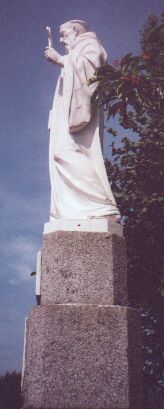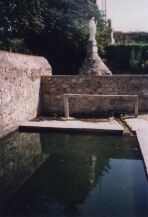Today is Saint Helier's Day and nothing seems to be known of Jersey history before the arrival of Helier a missionary in the 6th century. He was born at Tongres, in Belgium, the son of the Saxon Governor, who was a pagan. As a boy Helier became a convert to Christianity and subsequently went to the Abbey of Nanteuil in France, where, under Marculf, he studied the Celtic language until about 540 AD, when he crossed to Jersey. There he took up his abode on a rock surrounded by the sea and communicating with the land by a natural causeway, which can be identified as "l'Islet", a rock south of the island upon which Elizabeth Castle stands in St. Aubin's Bay.
For fifteen years he worked among the inhabitants, his remarkable zeal and the holiness of his life making a great impression, and they soon became converted to the Christian faith.
At the end of that period, we are told, Jersey was visited by a band of the dreaded Saxon pirates, who landed without resistance and to whom Helier began to preach the Gospel in their own language, urging them to abandon their Way of life. He gave such spiritual force to his words that the pirate chief, fearing that his followers would be thus induced to give up their present mode of living, struck with his axe and Jersey's first martyr fell lifeless at his feet.
Crossed axes
The pirates became terrified at this awful murder and, although the weather was stormy, they immediately put to sea, but their ship struck a rock and they all perished. The very spot where Helier is reputed to have lived, with an "oratory" built over the cell in the 14th century, may still be seen and is a place of pilgrimage. The emblem of crossed axes is the adopted flag for the parish, but the "true axes" according to Dean Falle, are to be seen only on the reredos of the altar in the parish church.
As with all saints, the legends surrounding are many, especially those in regard to the final resting-place of his body This seems never to have been established with any certainty, but the most likely is at Baubec, near Rouen. Throughout Northern France are a few churches and altars dedicated to St Helier, and there is a little chapel bearing that name in Trenton Cathedral, New Jersey, the altar stone being a piece of granite which was once in Mont Orgueil Castle.
Some time ago a chance remark by a lady that many years before she had seen a statue of St. Helier outside a little church in the village of Bréville in Normandy sparked off the desire to visit that place and to glean any relevant information. Some five visits have been made over a period of about two years and the outcome, at least to me has established a definite link between Jersey and this little village which lies just north of Granville. The coastline at Bréville is bleak and exposed, with sand dunes running down to the beach very similar to our own Five Mile Road. The village is about half a mile inland and the little church would not look out of place if transported to Jersey. Of special interest, too, are the gravestones, many bearing names familiar to us all, most prominent being that of Le Vavasseur.
Metal statue
It is the north-east corner of the churchyard, however, that becomes the focal point, for there is to be found a covered well surmounted by a five-foot statue of a benevolent-looking gentleman holding aloft a cross in his left hand and a bible in his right. This statue of St. Helier is of painted metal and was made at St Sulpice in Paris. It was placed there in 1888 to mark a pilgrimage or jubilee that took two years previously and the whole structure is about twelve feet high. Nearby is the parochial "lavoir" or place for the communal washing of clothes, still quite common throughout France.

From talking to many of the very friendly inhabitants of Bréville, and in particular to Madame Le Tourgeon, who with her husband lived in the presbytery, the fact was established that in the 12th century the church was dedicated to the Virgin Mary. That is why the village holds a "fête" on August 15 (the day of the falling asleep of the Virgin, and incidentally, this is the day on which St. Helier's Parish Church was reconsecrated in 1341, presumably after a restoration.

French legends
Like ourselves, throughout the centuries the inhabitants of Bréville have handed down legends. They believe that St. Helier, who has been styled "Bishop of Jersey", when he sensed that death was near, asked that he be laid to rest in his adopted village of Bréville. Eventually his wish was granted, for his body was placed in a stone coffin, the sea carrying it across to a little creek on the coast near Bréville; from there the villagers carried it with great pomp, but it was so heavy that they had to drop it. On that spot water appeared, and that of course is the site of the "fountain" or well. Throughout the ages people have gone there on pilgrimages, the water believed to have the power of healing eye afflictions.
So much for the legend, but it seems too that things have become a little mixed up. One story is that Helier must have evangelised the Cotentin (a part of Northern France) and became Bishop of Coutances; in fact over the fireplace of the presbytery living-room there is a very old and valuable tapestry depicting the saint with mitre and staff; this tapestry was originally in the church but for safety's sake is no longer kept there.
My informant also told me that St. Helier was believed to have been buried - or his body to have "rested" - where the church was built; there is a plaque with an inscription but with the years it has become illegible. A carving of St. Helier, however, is built into the reredos and would date from the same time as the building of the church in the 12th century. This statue - of wood - is very different from the one in the churchyard and shows a hermit-like man with a long pointed beard and probably more in keeping with the age than the metal figure.
It is interesting to note that the "fête" of St. Helier is celebrated in Coutances on July 16 - the same date of course, as is observed here - and a panel in one of the beautiful stained-glass windows of Coutances Cathedral depicts St. Helier in a boat with his tutor St. Marculf.
Creating a link
It is not intended to indulge in verbal combat as to the merit or not of the holy man or to juggle with dates of varying degree. All that one has set out to do is to forge a link between Jersey and a little Normandy village. Whatever differences of opinion we may hold, there must have been a basic "something" on which ordinary folk have built their own sentiments.
If throughout the generation the vision, spirit, example - call it what you will - of St. Helier has helped other humble men and women to get a little nearer the Christian ideal, then all stories and legends count for naught. Only results remain.
L.P. Sinel
Evening Post 16/7/1966

R'tou à la page d'siez-mé | Back to home page
E-mail: geraint@societe-jersiaise.org